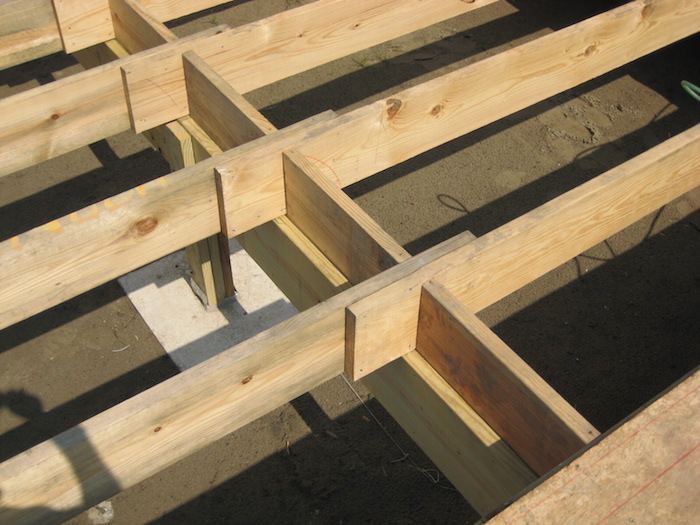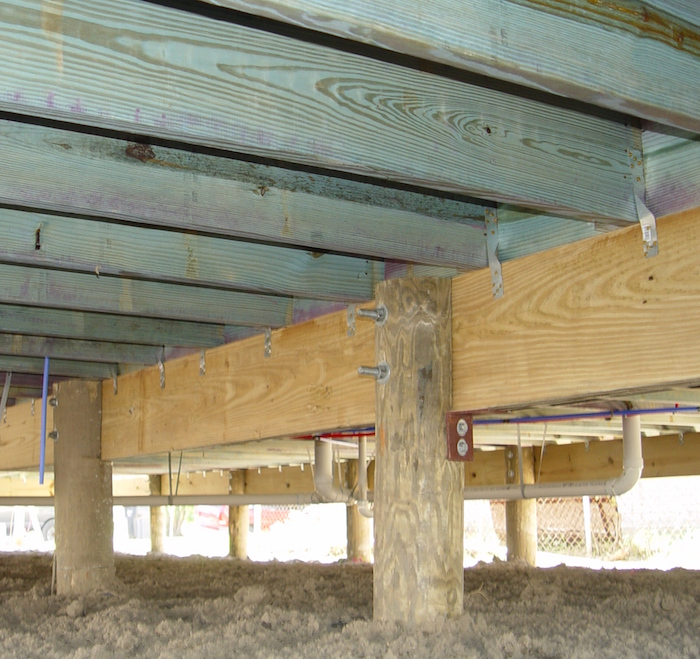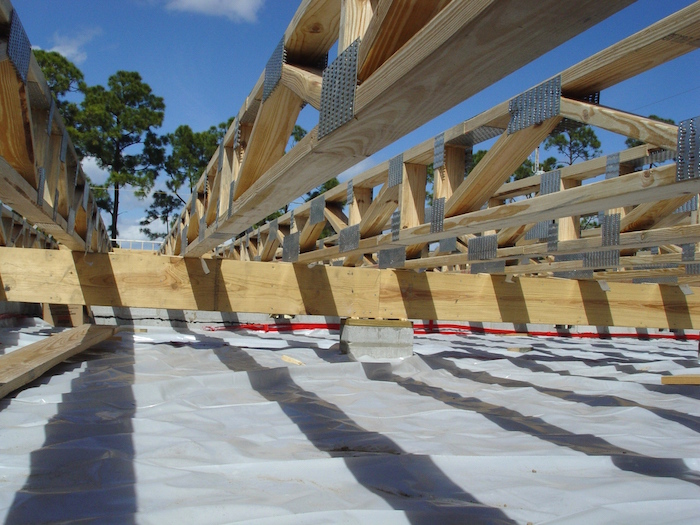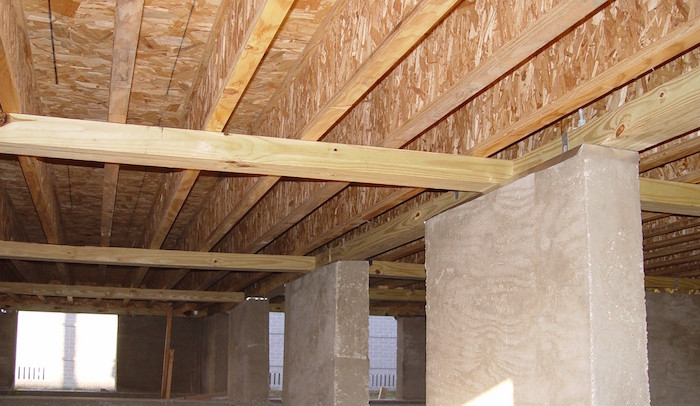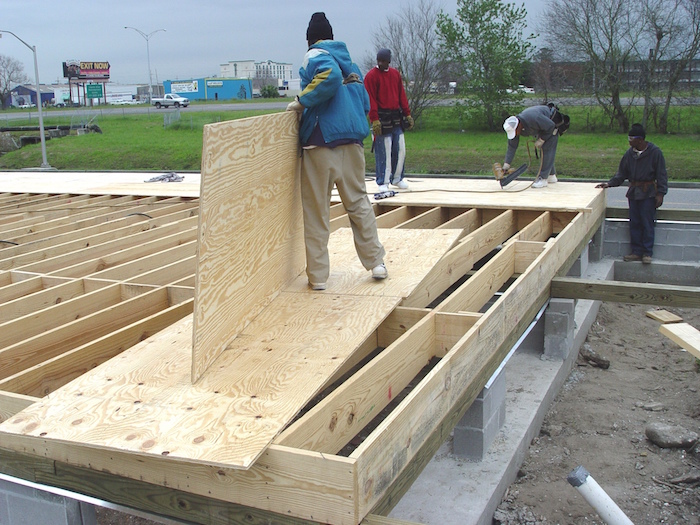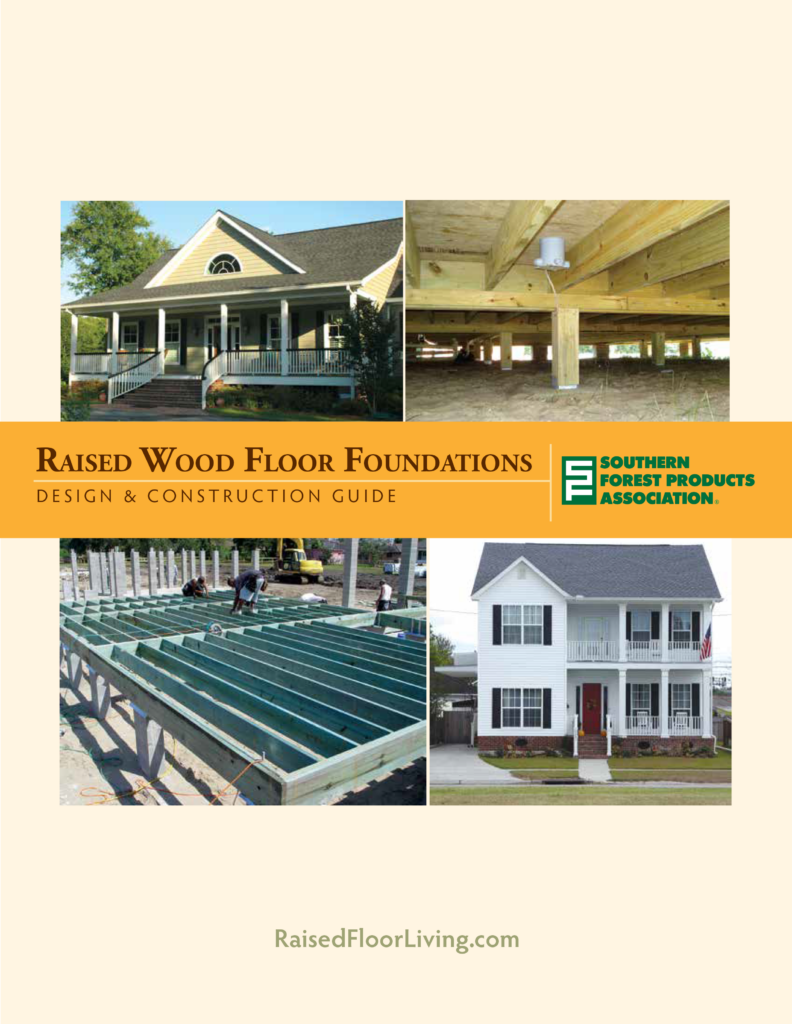Lumber and Materials
Raised Wood Floor
Foundation Lumber and Materials
To ensure the safe and durable construction of a raised wood floor foundation, wood products need to conform to appropriate product standards as specified in building codes.
In 1924, solid-sawn lumber became the first wood framing product to be governed by a set of industry standards. Since that time, industry standards have been established for many other engineered wood framing products used in raised wood floor foundations. Today’s builder can choose from a range of excellent wood framing products of consistent quality and uniformity.
Generally, building codes require pressure-treated or naturally durable wood, especially Southern Pine, for the following applications related to raised wood floor foundations:
- Joists, or the bottom of structural floors without joists, that are within 18 inches of exposed soil.
- Beams or girders closer than 12 inches to exposed soil.
- Framing members (including sheathing) which rest on exterior foundation walls and are less than 8 inches from soil.
- Plates, sills, and sleepers on concrete or masonry
- Wood in permanent structures closer than 6 inches to soil
- Girders entering exterior masonry or concrete walls without a minimum of one-half inch of air space on its top, sides, and end.
- Posts or columns not separated from concrete piers by an impervious moisture barrier.
- Wood supports that are embedded in, or in contact with, the ground.
Lumber and Timbers
Solid-sawn dimension lumber, 2 inches to 4 inches thick, is typically used for floor joists, sill beams, and girders in raised wood floor foundations. Timbers, 5 inches × 5 inches and larger, are frequently used for girders and sill beams in a floor system.
Lumber and timbers must be properly grade marked. Southern Pine grade marks identify the grade, species, moisture content, producing mill, and inspection service.
Timber Piling
Foundation piles are typically pressure-treated Southern Pine timber members driven and embedded into the ground. In some areas, soil conditions dictate timber piling for a raised wood floor system deep foundation.
ASTM D25 Standard Specification for Round Timber Piles establishes physical properties and manufacturing requirements. Round timber pilings used for foundations, as well as land and freshwater applications should meet AWPA standards in Use Category 4B, Piles — Preservative Treatment by Pressure Processes.
Glued Laminated Timber
Glued laminated timber, or glulam, is comprised of individual pieces of lumber end-jointed and bonded together with adhesives to produce long lengths and the required beam dimensions.
Glulam is generally used as a girder or beam in a floor system. Glued laminated timber must meet the provisions of ANSI/AITC A190.1 American National Standard for Structural Glued – Laminated Timber or the manufacturer’s proprietary code report.
Metal Plate Connected Wood Trusses
Wood trusses are assembled using dimension lumber and metal connector plates. Parallel-chord trusses are typically used as joists in raised wood floor systems.
Assemblies using prefabricated wood trusses must meet the provisions of the governing building code and any additional requirements in the ANSI/TPI 1-2014: National Design Standard for Metal Plate Connected Wood Truss Construction.
Prefabricated Wood I-joists
Wood I-joists are manufactured using sawn or structural composite lumber flanges and structural panel webs that are bonded together with exterior-type adhesives, forming an “I” cross-section.
I-joists are commonly used for floor joists. Systems using wood I-joists must meet the provisions of ASTM D5055 Standard Specification for Establishing and Monitoring Structural Capacities of Prefabricated Wood I-Joists, the governing building code, and any additional requirements in the manufacturer’s proprietary code report.
Structural Composite Lumber
Structural composite lumber (SCL) is generally used as a girder, beam, or band joist (rim board) in a raised wood floor system. It is manufactured with parallel-laminated veneers or a network of wood strands laminated together with a waterproof adhesive. Common forms of structural composite lumber include parallel strand lumber (PSL), laminated veneer lumber (LVL), and laminated strand lumber (LSL).
Structural composite lumber must meet the provisions of ASTM D5456 Standard Specification for Evaluation of Structural Composite Lumber Products, the building code, and any additional requirements as listed in the manufacturer’s proprietary code report.
Structural Wood Panels
Wood panels can be manufactured in a variety of ways:
- plywood (cross-laminated wood veneer)
- oriented strand board or OSB (wood strands arranged in cross-oriented layers)
- composite panels (veneer faces bonded to wood strand cores).
Plywood used in structural applications must meet the provisions of U.S. Department of Commerce Voluntary Product Standard 1 (PS1) Construction and Industrial Plywood, or U.S. Department of Commerce Voluntary Product Standard 2 (PS2) Performance Standard for Wood- Based Structural-Use Panels, or the manufacturer’s proprietary code report.
OSB used in structural applications should meet the provisions of Voluntary Product Standard 2 (PS2) Performance Standard for Wood-Based Structural-Use Panels or the manufacturer’s proprietary code report.
Rim Boards
Rim board can be manufactured using plywood, OSB, glulam, or SCL. Rim board is designed to work in concert with a wood I-joist system, filling the space between the sill plate and the bottom wall plate, or between the top plate and bottom plate in multi-floor construction.
Wood structural panel rim board must meet the provisions of the Performance Standard for APA EWS Rim Boards or the manufacturer’s proprietary code report.
Glulam rim boards are a re-sawn grade of glued-laminated timber manufactured in accordance with the Performance Standard for APA EWS Rim Boards and ANSI/AITC A190.1.
Additional product information (design values, span tables, etc.) about the materials described above can be obtained from various wood industry organizations including:
Check out our Raised Wood Floor Foundations publication, a comprehensive design and construction guide for using Southern Pine for raised wood floor systems.
Click below to learn more about:
